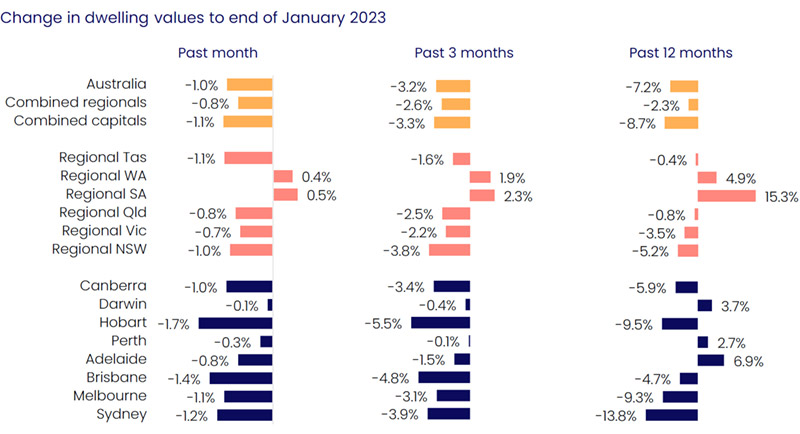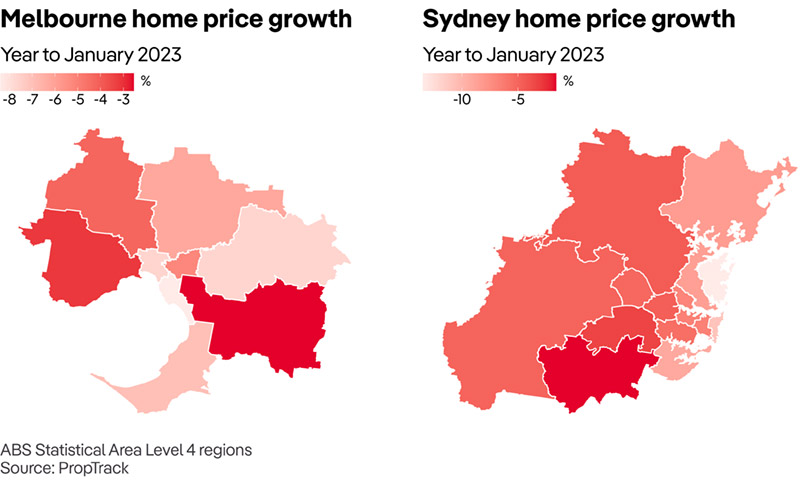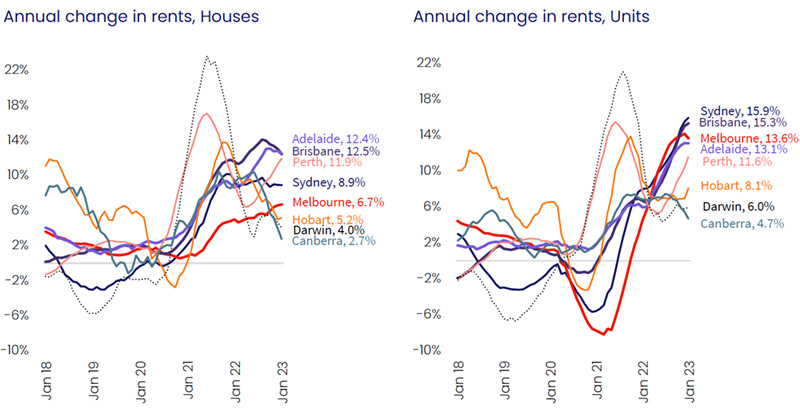National property market continues its downhill slide
National property prices have fallen 8.9 per cent since peaking in April last year, making this the largest and fastest decline in values since at least 1980 when CoreLogic’s records began.
Australia’s housing market decline has spread across all capital cities and most regional areas, with a leading index showing the property price slides are widespread but slowing in momentum.
CoreLogic’s home value index slumped 1.0 per cent in January, marking a new record for how much and how fast dwelling values have fallen in Australia.
Based on the monthly index, the national HVI is down 8.9 per cent since peaking in April last year, making this the largest and fastest decline in values since at least 1980 when CoreLogic’s records began.
There were signs, however, that the rate of decline was easing. January’s national drop was the smallest month-on-month decline since June last year.

Source: CoreLogic Home Value Index - February 2023
A separate index by rival data provider PropTrack, using a different methodology, had prices falling a much smaller 0.09 per cent last month, bringing prices down 4.51 per cent from their peak in March 2022.
Both indices concur that nearly all cities and regions in Australia are now in a property downturn, with key points of difference being PropTrack’s finding that Perth is still marginally in positive territory for the month, up 0.06 per cent, as opposed to down 0.3 per cent according to CoreLogic.
The CoreLogic data released early Wednesday (1 February) concluded that every capital city posted a decline in dwelling values through the month, led by Hobart (-1.7 per cent) and Brisbane (-1.4 per cent), while the smallest drops were recorded in Perth (-0.3 per cent) and Darwin (-0.1 per cent).
Sydney’s median dwelling value dropped below $1 million for the first time since March 2021, falling 1.2 per cent in January, an improvement on December’s 1.4 per cent decline.
Despite the recent sharp drop in values, every capital city and rest-of-state region is still recording home values above pre-pandemic levels, although Melbourne’s index would only need to fall a further 0.4 per cent before equalling the March 2020 reading.

PropTrack Senior Economist, Eleanor Creagh, said that despite recent falls, prices nationally are still 28.5 per cent above their pre-pandemic levels.
“The worst of the downturn appears to have passed,” she said.
“The rapid pace of price falls seen in June and July 2022 when interest rates first started rising has subsided and price falls have eased in most capital cities in recent months.”
RSM Australia's national director of property and construction, Adam Crowley, told API Magazine that prospective property buyers were still in a wary and watchful mood.
“While the movement in interest rates has been a major contributor to the property market correction, the sector remains sensitive to a broader variety of factors, including uncertain economic conditions and a slowdown in immigration.
“There is very much a sense of ‘wait and see’ before taking action.
“As interest rates level out and economic sentiment improves the market will further stabilise,” Mr Crowley said.
Premium property price slide slowing
CoreLogic Research Director, Tim Lawless, said the most noticeable easing in value falls can be seen across the premium end of the housing market, where the country’s most expensive properties have led both the recent upswing as well as the current downturn.
Across the combined capitals, the rolling quarterly rate of decline in the upper quartile values has improved from a recent low of -6.1 per cent over the September 2022 quarter to -4.0 per cent over the three months to January.
“While this trend towards improving conditions across premium markets is not evident in all cities, it is most apparent in Sydney’s detached house market,” he said.
“Quarterly declines in this market segment eased from -7.7 per cent in the three months to August, to -3.9 per cent in the three months to January.
“The improvement could be reflective of more buyers taking advantage of larger price drops across the premium sector, where house values are down 17.4 per cent since peaking in January 2022,” Mr Lawless said.
Townhouses and terraced homes, especially in the more expensive price ranges, are also largely defying the wider property market downturns in Sydney and Melbourne.
Renters’ woes continue
Rents continue their steady and relentless push upwards as housing supply issues intensify competition among renters.
That situation appears set to worsen, with an influx of Chinese students expected to create a degree of chaos in CBD and rental markets close to universities, particularly in Sydney and Melbourne.
Rents nationally were up 0.7 per cent compared with a 0.6 per cent rise in December, according to CoreLogic’s Hedonic Home Value Index report. This was still well below the peak monthly rental growth rate from May 2022 (1.0 per cent). The rise in the pace of rental growth was centred in the capital city markets, where monthly rental growth lifted from 0.6 per cent in December to 0.8 per cent in January.
Unit rents have seen a surge in rental growth over the past year.
“This can be attributed to a combination of affordability pressures driving more rental demand towards cheaper rental options, and a possible reversal in rental preferences as tenants once again seek out housing options closer to centres of amenity such as the CBD and transport hubs,” Mr Lawless said.
Perth’s vacancy rate recently fell to just 0.6 per cent, its lowest level since 1980.

Source: CoreLogic Home Value Index - February 2023
A Chinese government ban on online studying could result in more than 40,000 Chinese university students arriving in Australia in the next few weeks, putting further heat on the already stretched unit and CBD markets.
Craig Hill, an education consultant from Craig Hill Consultancy Services, said China has decreed that they will no longer recognise purely online degrees, and have ordered all online students to return to their Australian university campuses immediately.
“The result will be that cashed up Chinese students will put a strain on our rental market, which is already at crisis point and particularly evident in Sydney, Melbourne and Brisbane,” Mr Hill said.
“There is not sufficient accommodation on campus to provide for all these students, with a lot of on-campus accommodation having been sold off over the last three years during COVID due to the fact it was sitting empty.
“Brisbane, for example, has only a 1 per cent vacancy rate for rentals, with many not able to afford the soaring rental prices that have occurred because of the Reserve Bank interest rate hikes.
“With thousands of students now expected to arrive in the city over the next month, rental prices are expected to soar even higher.”
While another interest rate rise appears likely next week, there are some nascent signs that the cycle of rate rises is finally taking effect.
Australian retail turnover fell 3.9 per cent in December 2022, according to figures released Tuesday (31 January) by the Australian Bureau of Statistics (ABS).
This follows a 1.7 per cent rise in November 2022, according to Ben Dorber, ABS Head of Retail Statistics.
“This is the first monthly fall in retail turnover for 2022, following eleven consecutive monthly rises.”
“The large fall in December suggests that retail spending is slowing due to high cost-of-living pressures.”
The hope among borrowers is that reduced spending will take pressure off the high inflation that is forcing the RBA’s hand on interest rates.





















